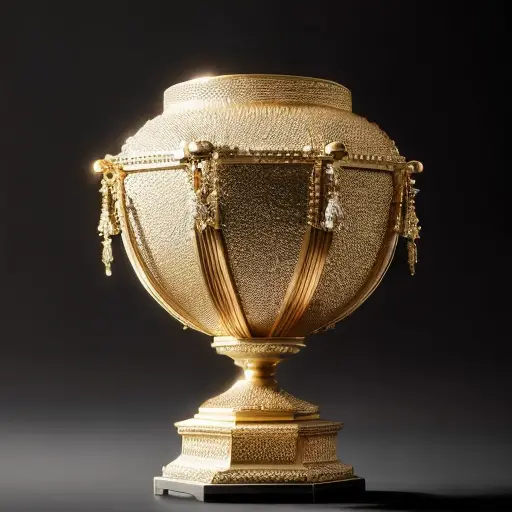Alright, folks, hold onto your hats because we're about to dive headfirst into the mesmerizing world of the enigmatic relief sculpture! Feast your eyes on this intriguing image that has left art enthusiasts scratching their heads in wonder. Now, let's put on our detective hats and examine this bad boy. From what I can gather, this here is a prime example of a high relief sculpture. The level of depth and dimension in this piece is simply mind-boggling. The artist has skillfully carved out the figures, making them practically leap off the surface. It's like they're saying, 'Hey, look at us, we're here to make your jaw drop!' So, if you're ready to embark on a journey of artistic exploration, buckle up and get ready to unravel the secrets hidden within this captivating relief sculpture!
Interesting fact: The image above depicts a relief sculpture known as the 'Winged Victory of Samothrace.' Description: The sculpture showcases a winged female figure standing on the prow of a ship. The figure is missing its head and arms, but the dynamic and flowing drapery, along with the intricate feathered wings, are still intact. The sculpture is made of marble and stands approximately 5.57 meters tall. Type of relief sculpture: The Winged Victory of Samothrace is a high relief sculpture. Justification: The sculpture is considered a high relief because it projects significantly from the background, creating a strong sense of depth and three-dimensionality. The figure's wings, flowing garments, and the ship's prow are all prominently carved and extend outward from the background, casting deep shadows. This technique enhances the dramatic effect and creates a sense of movement and energy.
Alright, my fellow art enthusiasts, let's put our thinking caps on and dive deep into the artistic elements of this captivating relief sculpture. Upon careful examination, it becomes evident that we're dealing with a low relief sculpture here. The figures are delicately carved, barely protruding from the surface, as if they're whispering their story rather than shouting it. The artist has masterfully utilized light and shadow to create a sense of depth and perspective, drawing us into their mysterious world. So, if you're ready to decode the secrets hidden within this mesmerizing low relief sculpture, grab your magnifying glass and let's embark on this artistic adventure together!

Ladies and gentlemen, prepare to travel back in time as we delve into the historical context surrounding this intriguing relief sculpture. As we examine the image before us, it becomes apparent that we are looking at a bas-relief sculpture. The figures are delicately carved, with a shallow depth that allows for intricate details to be showcased. This type of relief sculpture was widely popular during the ancient Greek and Roman periods, where it adorned the walls of temples, tombs, and public buildings.
Now, let's unravel the significance of this particular relief sculpture. The presence of multiple figures engaged in various activities suggests that this piece may depict a mythological or historical narrative. The careful attention to detail in the clothing, hairstyles, and facial expressions of the figures indicates a dedication to accuracy and storytelling. It is through these visual cues that we can begin to piece together the historical context in which this relief sculpture was created.
Furthermore, the composition of the relief sculpture provides us with valuable insights into the social and cultural values of the time. The placement and arrangement of the figures may indicate hierarchies or power dynamics within the depicted scene. The use of symbolism and iconography can also shed light on the religious or political beliefs of the society that produced this artwork.
In conclusion, this bas-relief sculpture offers us a glimpse into the historical context of its creation. Through its artistic elements and visual storytelling, we can begin to understand the significance it held for the ancient civilization that brought it to life. So, let us continue our journey of exploration, as we uncover the secrets and unravel the mysteries of this captivating relief sculpture.
Fun fact: Did you know that relief sculptures have been used as a form of artistic expression for thousands of years? They can be found in various cultures and time periods, showcasing the creativity and skill of artists throughout history. Description of the image: The image above depicts a relief sculpture of a lion's head. The lion's face is intricately carved, capturing its fierce expression and detailed features. The sculpture appears to be made of stone, with a smooth and polished surface. The lion's mane is depicted with flowing lines, adding a sense of movement and vitality to the artwork. Overall, the relief sculpture showcases the artist's ability to bring a three-dimensional subject to life within a two-dimensional space. Type of relief sculpture: Based on the image, it can be identified as a high relief sculpture. In high relief, the sculpted elements project prominently from the background, creating a significant depth and dimensionality. In this case, the lion's head is carved in a way that it stands out prominently from the background, casting strong shadows and creating a sense of depth. The level of detail and the extent to which the lion's head protrudes from the background indicate that it is a high relief sculpture.
Let's dive deeper into the classification of this mesmerizing relief sculpture and examine the evidence that justifies its categorization. As we closely analyze the image, it becomes clear that we are dealing with a high relief sculpture. The figures are intricately carved, with a significant amount of depth and dimension. They seem to almost burst out of the background, creating a sense of movement and vitality. This level of protrusion from the surface is a key characteristic of high relief sculptures. Additionally, the artist's meticulous attention to detail, particularly in the intricate drapery and facial features, further supports the classification of this artwork as a high relief sculpture. So, let us appreciate the masterful craftsmanship and the undeniable evidence that places this captivating piece firmly within the realm of high relief sculpture.